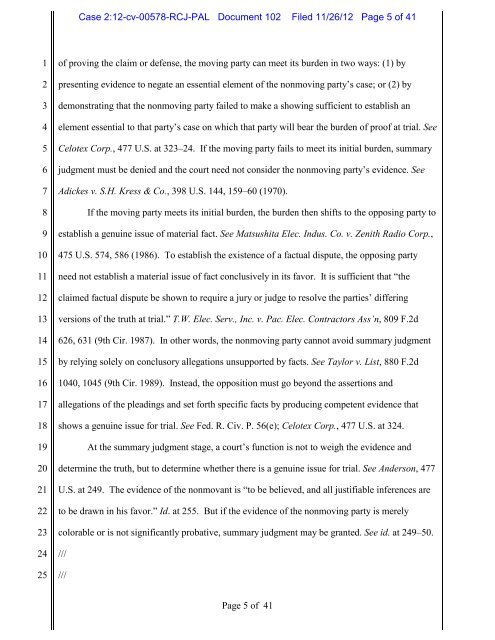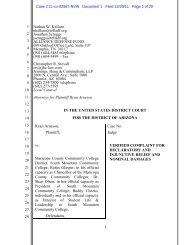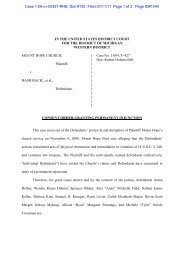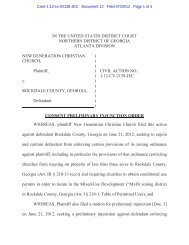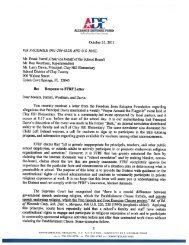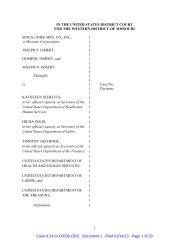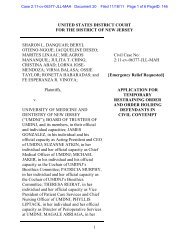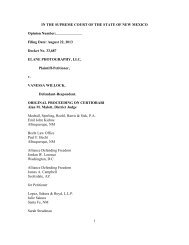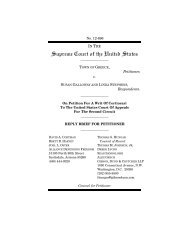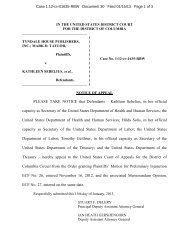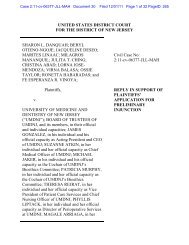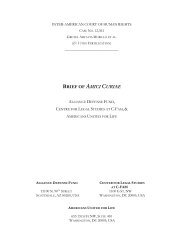ruling by Judge Robert C. Jones - KQED
ruling by Judge Robert C. Jones - KQED
ruling by Judge Robert C. Jones - KQED
You also want an ePaper? Increase the reach of your titles
YUMPU automatically turns print PDFs into web optimized ePapers that Google loves.
Case 2:12-cv-00578-RCJ-PAL Document 102 Filed 11/26/12 Page 5 of 4112345678910111213141516171819202122232425of proving the claim or defense, the moving party can meet its burden in two ways: (1) <strong>by</strong>presenting evidence to negate an essential element of the nonmoving party’s case; or (2) <strong>by</strong>demonstrating that the nonmoving party failed to make a showing sufficient to establish anelement essential to that party’s case on which that party will bear the burden of proof at trial. SeeCelotex Corp., 477 U.S. at 323–24. If the moving party fails to meet its initial burden, summaryjudgment must be denied and the court need not consider the nonmoving party’s evidence. SeeAdickes v. S.H. Kress & Co., 398 U.S. 144, 159–60 (1970).If the moving party meets its initial burden, the burden then shifts to the opposing party toestablish a genuine issue of material fact. See Matsushita Elec. Indus. Co. v. Zenith Radio Corp.,475 U.S. 574, 586 (1986). To establish the existence of a factual dispute, the opposing partyneed not establish a material issue of fact conclusively in its favor. It is sufficient that “theclaimed factual dispute be shown to require a jury or judge to resolve the parties’ differingversions of the truth at trial.” T.W. Elec. Serv., Inc. v. Pac. Elec. Contractors Ass’n, 809 F.2d626, 631 (9th Cir. 1987). In other words, the nonmoving party cannot avoid summary judgment<strong>by</strong> relying solely on conclusory allegations unsupported <strong>by</strong> facts. See Taylor v. List, 880 F.2d1040, 1045 (9th Cir. 1989). Instead, the opposition must go beyond the assertions andallegations of the pleadings and set forth specific facts <strong>by</strong> producing competent evidence thatshows a genuine issue for trial. See Fed. R. Civ. P. 56(e); Celotex Corp., 477 U.S. at 324.At the summary judgment stage, a court’s function is not to weigh the evidence anddetermine the truth, but to determine whether there is a genuine issue for trial. See Anderson, 477U.S. at 249. The evidence of the nonmovant is “to be believed, and all justifiable inferences areto be drawn in his favor.” Id. at 255. But if the evidence of the nonmoving party is merelycolorable or is not significantly probative, summary judgment may be granted. See id. at 249–50.//////Page 5 of 41


